Like a rock, elm that is
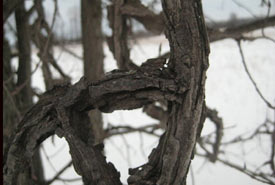
Short, gnarly side branches all the way up the tree (Photo by Bill Moses)
My interest in botany came late in life. To compensate, I have restricted my primary interest to approximately 175 species of native woody plants of Grey and Bruce Counties. I try to give each one of them equal status and attention. Building on that, I tend to favour the ones that might not be in the public eye. I also tend to the historical: what is the history of the plant? Why is bush honeysuckle named Diervilla lonicera? Delving into the history can lead you to many places.
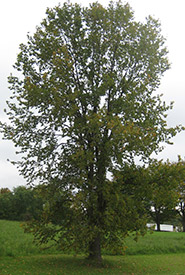
Rock elm tree leafed out (Photo by Bill Moses)
Rock elm first came to the attention of the botanical world in 1831 when the American Journal of Science and Arts published the plant's description and scientific name. The author was David Thomas, an American engineer in charge of building the Erie Canal, who reported finding the tree in Cayuga County, New York. Thomas was a serious amateur botanist in what was an exciting time for naturalists. Many new species were being discovered, and the explorers Lewis and Clark, for example, made a point of acquiring botanical skills so they could properly document their discoveries.
Thomas, as was his right, named the “new” tree Ulmus racemose (the species’ name means raceme, a flower cluster in which each flower grows on its own stalk from a common stem). In 1902, Charles Sprague Sargent, a well-known botanist and the first director of Harvard University's Arnold Arboretum in Boston, Massachusetts, changed the species’ name to thomasii in Thomas’s honour when he discovered that the racemosa species name already belonged to a European elm.
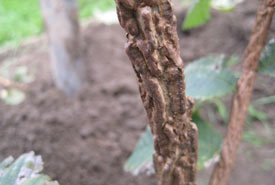
Corky branch of a rock elm (Photo by Bill Moses)
Sargent described rock or cork elm as, “heavy, hard, very strong and tough, closely grained and susceptible of receiving a beautiful polish.” He noted that it was used in the manufacture of heavy agricultural equipment such as mowing and threshing machines. Rock elm was also crafted into chair frames, wheel hubs and the beams of stump pullers. The wood was put to good use as railway ties, bridge timbers and traditional timber framed buildings. Rock elm was also used to build log cabins and even burned as fuel to heat them.
Decades later, automobile bodies, pianos, hockey sticks and axe handles were made from rock elm. Sadly, the wood is no longer commercially available. Trees that were once 25 to 30 metres (80 to 100 feet) in height, with a trunk that sometimes reached one metre (three feet) in diameter with 20-metre (60-foot) logs clear of knots are now nearly all gone.
In the 1895 Silva of North America (vol. 7) it was stated that, “The value of the wood of the Rock Elm threatens its distinction; and most of the large trees have already been cut.” Today, while rock elm is not listed as endangered, it has greatly declined and is now rare in much of its range.
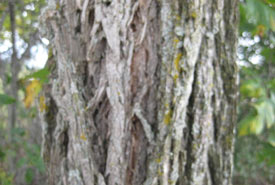
Fissured bark on the main trunk (Photo by Bill Moses)
Rock elm has a strong central stem and, when it grows in the open, short, gnarly side branches all the way up the tree. Closer inspection reveals corky branches and very fissured bark on the main trunk. The leaves tend to be concave, with the lateral veins closer together than on white (American) and slippery elms. The side veins are also rarely branched.
If you run your finger from the tip of the leaf to its base, the leaf will feel smooth, or at least smoother than the other elms. Lacking the short, stiff hairs that cause this roughness, the leaf might appear shinier/greener than those of its cousins. The winter buds are also an excellent identification feature. The buds are pointier, shinier and a bright yellowish/brown, lighter coloured than the other two elm species.
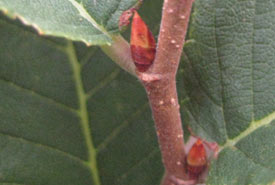
Buds of rock elm branch (Photo by Bill Moses)
Locating a rock elm and collecting its seed had been on my bucket list for years. It took me a while to learn to recognize them but after identifying my first one I found I had been overlooking them, thinking they were scrubby American elms. While American elm produces seed pretty much every year in my area, which probably has to do with rock elm being at the edge of its northern range as opposed to American elm, whose range reaches much further north, rock elm produces seed every five years, more or less. I was surprised to find that the elms are wind-pollinated. They do have perfect flowers (both male and female parts) and I have seen bees “working” the flowers.
I suspect now that they must have been just gathering pollen and not playing a necessary role in the reproductive process. Plants that require insect pollination have sticky pollen, which is preferred by bees because it is easier to gather. Another interesting fact is that rock elm is self-fertile, meaning you do not need two trees to produce seed. American elm is not! Along with any reference to seed collecting, of course, must go a caution not to collect seed from protected areas. Guidelines for seed collecting can be found here, on the North American Native Plant Society’s website.
Although rock elm seed is classified as a samara (a seed with wings), the hairy seed does not travel far from its parent. It’s full of nutrients, and therefore, a favourite with birds and small animals. Rock elm seed does not require cold stratification in order to germinate, so you can plant it directly into the soil and have some nice seedlings within a few months. (Note to seed collectors: slippery elm is even harder to find in my area than rock elm but they usually produce seed with the same frequency.)
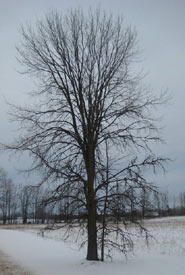
Rock elm in the winter (Photo by Bill Moses)
A 1971 range map for rock elm can be found on the Geosciences and Environmental Change Science Centre’s website. Its habitat is limited to drier, more upland sites than white elm, which occurs in lowlands and tolerates urban stresses. Rock elm is not shade-tolerant but seems to grow anywhere except where there is standing water for part of the year. At one time, rock elm could grow tall and strong enough to compete in forest conditions, developing very long trunks (that translated into valuable logs) to support the crown. Nowadays, rock elm appears to grow mostly in the open as a small tree with branches for most of its length. The shallow roots of older trees sucker up and form dense colonies.
Dutch elm disease has been just as devastating to the rock elm (and slippery elm) as it is to the more abundant white elm.
We have rock elm seedlings at our Inglis Falls Arboretum propagation area in Owen Sound, but there is little demand for them. I urge tree lovers to consider planting this species since it is rare in much of its native range. Perhaps if we plant “rocks” now, our great grandchildren will be able to marvel at these magnificent trees for years to come.
This post originally appeared in the The Blazing Star (North American Native Plant Society's newsletter) and is republished with permission from the author and publisher.


